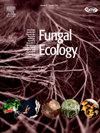在镰刀菌中,菌丝内细菌群落调节真菌对丝球相关细菌的反应
IF 2.2
3区 环境科学与生态学
Q3 ECOLOGY
引用次数: 0
摘要
真菌和细菌在土壤环境中形成复杂的关联,这可能影响它们的共生关系。虽然以前的研究已经独立地研究了菌丝内细菌或菌丝相关细菌群落与真菌的相互作用,但关于菌丝相关细菌如何调节菌丝内细菌群落和真菌反应的关键知识差距仍然存在。本研究调查了孢球相关细菌与含有天然菌丝内细菌(主要由Cutibacterium, Acinetobacter, Pelomonas, Achromobacter, Citrobacter和其他数量较少的菌丝内细菌组成)的三种镰刀菌分离物共同培养的影响,以及抗生素处理过的菌丝内细菌群落减少的对应物。该研究确定了真菌生长和微生物组成的变化,当与四个根际细菌分离物(假单胞菌、芽孢杆菌、窄养单胞菌和根瘤菌)单独或混合培养时。结果表明,菌丝内细菌调节真菌对菌丝相关细菌共培养的反应,野生型真菌的生长抑制作用通常较低,菌丝内细菌的多样性和数量减少。然而,当真菌暴露于合成的菌丝相关细菌混合物中时,与单一菌丝相关细菌处理相比,所有真菌分离物都刺激了菌丝内细菌群落,导致菌丝内细菌多样性更高。这些发现强调了考虑真菌微生物组内复杂相互作用的重要性,表明菌丝内细菌对菌丝相关细菌群落的组成动态响应。我们的研究结果也为菌丝内和菌丝相关细菌群落之间的相互作用如何在土壤环境中塑造真菌生物学提供了新的见解。本文章由计算机程序翻译,如有差异,请以英文原文为准。
Endohyphal bacterial communities modulate fungal responses to hyphosphere-associated bacteria in Fusarium
Fungi and bacteria form complex associations in soil environments, which can impact their symbiotic relationships. While previous studies have examined either endohyphal bacteria or hyphosphere-associated bacterial community interactions with fungi independently, a critical knowledge gap remains related to how hyphosphere-associated bacteria modulate the endohyphal bacterial communities and fungal responses. This study investigated the impact of hyphosphere-associated bacteria co-culture with three Fusarium isolates containing natural endohyphal bacteria (composed primarily of Cutibacterium, Acinetobacter, Pelomonas, Achromobacter, Citrobacter, and other less abundant species) and their antibiotic-treated counterparts with reduced endohyphal bacterial communities. The study determined the changes in fungal growth and microbiome composition when co-cultured with individual or a bacterial mix of four rhizosphere bacterial isolates (Pseudomonas, Bacillus, Stenotrophomonas, and Rhizobium). Results showed that endohyphal bacteria modulated fungal responses to hyphosphere-associated bacteria co-culture, with wild-type fungi typically exhibiting lower growth inhibition than their counterparts with reduced diversity and quantity of endohyphal bacteria. However, when the fungi were exposed to a synthetic hyphosphere-associated bacterial mix, all fungal isolates stimulated the endohyphal bacterial community leading to higher endohyphal bacterial diversity compared to single-species hyphosphere-associated bacterial treatments. These findings highlight the importance of considering complex interactions within the fungal microbiome, demonstrating that endohyphal bacteria respond dynamically to the composition of hyphosphere-associated bacterial communities. Our results also provide new insights into how the interplay between endohyphal and hyphosphere-associated bacterial communities shape fungal biology in soil environments.
求助全文
通过发布文献求助,成功后即可免费获取论文全文。
去求助
来源期刊

Fungal Ecology
环境科学-生态学
CiteScore
5.80
自引率
3.40%
发文量
51
审稿时长
3 months
期刊介绍:
Fungal Ecology publishes investigations into all aspects of fungal ecology, including the following (not exclusive): population dynamics; adaptation; evolution; role in ecosystem functioning, nutrient cycling, decomposition, carbon allocation; ecophysiology; intra- and inter-specific mycelial interactions, fungus-plant (pathogens, mycorrhizas, lichens, endophytes), fungus-invertebrate and fungus-microbe interaction; genomics and (evolutionary) genetics; conservation and biodiversity; remote sensing; bioremediation and biodegradation; quantitative and computational aspects - modelling, indicators, complexity, informatics. The usual prerequisites for publication will be originality, clarity, and significance as relevant to a better understanding of the ecology of fungi.
 求助内容:
求助内容: 应助结果提醒方式:
应助结果提醒方式:


